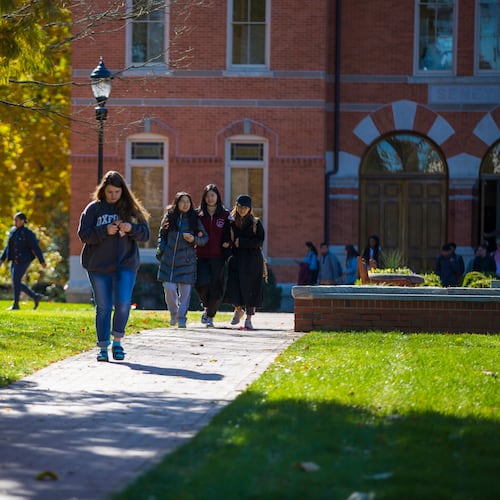Dr. Colleen Kelley was hopeful that the COVID-19 vaccine she and a vast team at Emory University had been researching for months was safe and effective. But they weren’t entirely sure until one morning last month when her smartphone buzzed repeatedly with news alerts.
Moderna, the manufacturer working with Emory and other researchers across the country on the vaccine, announced it had about a 95% efficacy rate, much higher than the 60% to 70% rate Kelley hoped for when they started their work. The company shortly thereafter submitted a request to the federal government for emergency use authorization of the vaccine.
Vaccine development is a complex process that typically takes years. Yet Moderna was the second vaccine maker last month to seek authorization for a COVID-19 vaccine. About a week earlier, Pfizer and its German partner BioNTech had asked for emergency use authorization for their vaccine, which had had a 95% efficacy rate.
A panel of outside experts on Thursday recommended that the U.S. Food and Drug Administration grant Pfizer’s EUA request. U.S. Health & Human Services Secretary Alex Azar said Friday morning the FDA is working on final approval, and dosages of the Pfizer vaccine could be administered by next week.
The FDA committee is scheduled to review Moderna’s EUA request on Thursday .
One reason for the speed of vaccine development was that both vaccines adapted messenger RNA technology developed years ago for other medical research. Unlike other vaccines, the mRNA vaccines don’t use a live virus. Instead, these give cells instructions to make a harmless protein piece to trigger an immune system response.
“Once the scientists were able to develop the genetic code of the virus that causes COVID-19, they used the existing technology for this new vaccine,” said Dr. Valeria Cantos, an assistant professor in Emory’s Division of Infectious Diseases.
Technological advancements in replicating RNAs, building DNA templates, digitizing clinical studies and scaling up manufacturing also helped, Pfizer CEO Dr. Albert Bourla has said.
Kelley and others also attribute the speed to an unprecedented amount of money from the federal government — more than $9 billion — and people committed to vaccine development. By contrast, federal HIV/AIDS research funding was about $2.5 billion during a 12-month stretch that ended in September 2019.
The Emory team worked with the hope that one phase of its research would be successful while starting on the next phase.
“A lot of people during the pandemic have said we learned how to fly the plane as we were building it,” said Kelley, an associate professor at Emory’s Division of Infectious Diseases who has research experience in HIV medicine, HIV epidemiology and clinical outcomes research. “It was the same for clinical trials. We had to pick up and keep going without knowing what our outcomes would look like.”
While the surprisingly fast pace of the development has thrilled many scientists, its speed has troubled many Americans who suspect the vaccines may not really work or have unknown side effects. Polls had been showing that about one-half of Americans have said they will not get vaccinated, though a Dec. 8 Gallop poll showed that up to 63% are now willing.
The United Kingdom, which approved use of the Pfizer vaccine earlier this week, has warned people with a history of allergic reactions against being vaccinated after two healthcare workers had an adverse reaction. U.S. officials have discussed similar warnings. Some speakers said during Thursday’s FDA committee meeting on Pfizer’s vaccine that federal officials have not released enough trial data research. The critics also said not enough Blacks and Hispanics, who have been disproportionately impacted by the disease, were included in research. A few urged the committee to either wait for more trial research results or limit vaccine use to a small group of recipients.
Researchers at Emory and elsewhere insist no shortcuts were taken and their work was done with the primary goal of making sure it is safe.
Emory had a major role in the Moderna research. Seventeen of the 45 Phase 1 study participants and about 700 of the approximately 30,000 Phase 3 trial participants were through Emory.
Emory’s Hope Clinic, where much of its vaccine research was done, increased its workforce from about 70 employees to 125, Kelley said. Many people worked more than 70 hours a week, she said. They hired more clinical research coordinators, nurses, staff to collect blood samples and phone operators to field calls from people interested in volunteering in trial research. Kelley’s team also had to find additional space, and get local permits, to do its work.
A key element to the research was finding study volunteers. It wasn’t easy.
Emory worked with community organizations it partnered with on other research to find volunteers, particularly those from Black and Hispanic communities. Moderna has said 37% of Phase 3 trial volunteers are racial and ethnic minorities. Cantos recalled vaccine study candidates asked questions about its safety, side effects, whether the dosages included COVID-19 and why researchers were so focused on getting participants from these communities in the research.
“They really wanted to be sure they weren’t being treated as guinea pigs,” Cantos said.
Most decided to participate in the study, Cantos said, after being told participation was voluntary.
Kelley said they suspected their research might be effective after Phase 1 results showed a positive response in the first group of student participants, who were tested in late March and early April. Moderna released findings in July that showed high levels of neutralizing antibody activity that were above the average levels seen in blood serum obtained from people recovering from the disease. No serious side effects were found.
The Emory team didn’t have prior access to Moderna’s complete findings, so they learned many of the results at the same time as the rest of the world.
Many volunteers, like lifelong Georgian Dorothy Scott, said they stepped forward partly out of concern that they might get exposed to COVID-19 and wanted to help with the research.
Scott, 91, got her second shot in mid October. The retired insurance underwriter said she wasn’t nervous. Scott had a slight temperature and felt a little soreness in one arm, but nothing else. She’s excited about what federal officials have said about the vaccine.
“I’m pleased with the outcome,” Scott said Wednesday, encouraging others to get vaccinated.
Emory medical student Sean Doyle, 32, participated in the first phase of the study. He also received two vaccine dosages.
Emory continues to monitor Doyle and other study participants. He’s had no side effects, but others have had slight fevers or chills after the second dosage.
Credit: Christina Matacotta
Credit: Christina Matacotta
Doyle’s parents participated in the third phase of the Moderna research and he said they’re fine. Like others, he’s amazed by the developments since March.
“I’m really happy I was able to contribute in this way, especially for the initial safety study for the Phase 1 trial, when a lot less was certain about the Moderna vaccine,” Doyle said. “So it is really cool to see how far it’s come and to have kind of been in the leading edge of testing for this vaccine. It’s exciting to know the benefits of this are going to reach millions of people soon.”
About the Author
Keep Reading
The Latest
Featured



